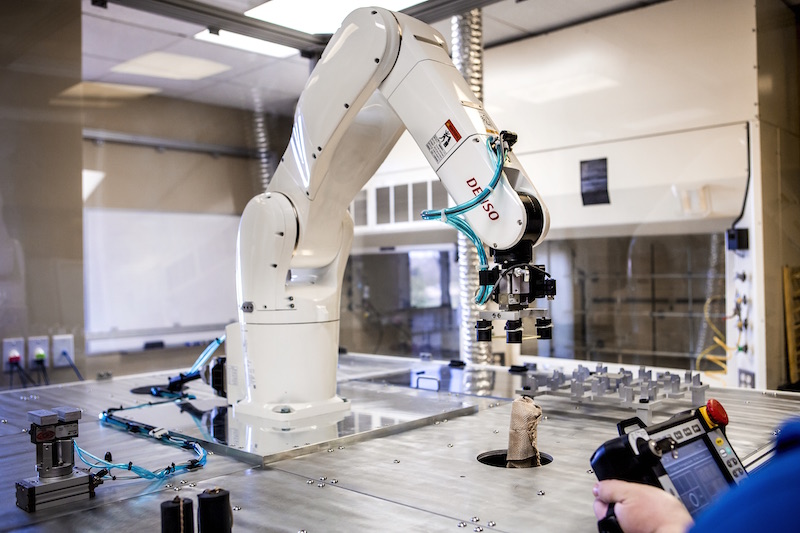With student presentations, exhibits from nationally renowned artists and historic collections, our many galleries, libraries and museums are great places to find inspiration.
Innovation Park
Since its inception in 1988, LSU Innovation Park has assisted 7,247 businesses and entrepreneurs and helped start 604 businesses. The ProtoStripes Center has created 160 prototypes since its inception in September 2014. The Student Incubator has assisted over 250 businesses since 2010.

Rural Life Museum
LSU's Rural Life Museum was voted one of the “Top 10 Outdoor Museums in the World” by the British Museum. Containing the largest collection of material culture of 19th century Louisiana, the Museum also houses artifacts dealing with everyday rural life up to the early 20th century.
| During the past year, LSU students have performed more than 100,000 hours of community service. |
| The U.S. Department of Education has announced the 2017 U.S. Department of Education Green Ribbon Schools, District Sustainability Awardees and Postsecondary Sustainability Awardees, and LSU is one of nine institutions of higher education recognized this year. |
| LSU won first place in the nation and in the SEC in the GameDay Recycling Challenge by recycling over 84,000 pounds of waste from the LSU vs. Arkansas game in a campaign entitled “Get Caught Green Handed". |
| LSU Libraries received national recognition at the annual Book & Media Awards Ceremony
at the midwinter meeting of the American Library Association (ALA) on January 10,
2016.
“Free People of Color in Louisiana: Revealing and Unknown Past,” a collaborative digital project led by LSU Libraries, was one of only four resources nationwide to make the annual list of Best Historical Materials, announced by the Reference and User Services Association (RUSA) during the Book and Media Awards Ceremony at the ALA’s Midwinter meeting in Boston. |
| In 2015, university publisher LSU Press received honors from two national award bodies, The PROSE Awards and the Association of American University Presses, or AAUP. While both entities recognize the value of the author’s manuscript, these awards also focus on the expertise of the publisher. |
| LSU’s Hill Memorial Library houses one of the world’s premier collections of chess literature, the Gladney Chess Collection, relating to the history and play of the game. |
| The LSU Museum of Natural Science has the world's oldest and largest collection of genetic resources for molecular genetic research on vertebrates. Such collections are fast becoming the most important museum collections, because the growth of genetic engineering and biotechnology has dramatically increased the demand for vertebrate tissue. The Smithsonian, American Museum of Natural History, Field Museum in Chicago, Berkeley, and other institutions have copied the LSU Museum model, but trail behind in size, importance, and use. |
| LSU’s Museum of Natural Science Collection of Genetic Resources is the largest tissue repository in the world -- and the first. Fifteen ultracold freezers and liquid nitrogen tanks in the Museum of Natural Science in Foster Hall house tissue samples of 70,000 individual birds -- one-half the bird species in the world -- 20,000 reptiles and amphibians, 5,000 mammals and a few fish. |
| LSU has the 66th largest university library in North America as ranked by the American Library Association. |
| In cooperation with the LSU Museum of Natural Science, the LSU Department of Biological Sciences directs the foremost graduate program in museum-based ornithology in the world. |
| As of the fall of 2008, the LSU Libraries hold 3,233,034 books, 6,663,531 microfilms and 321,348 maps. |
| The LSU Museum of Natural Science has the largest collection of bird DNA in the world. |
| The LSU Cartographic Information Center, located in 313 Howe-Russell Geoscience Complex, is part of the Department of Geography and Anthropology. With a collection of more than 500,000 cartographic items, including 321,912 maps, 124,522 aerial photographs, 16,000 hand-held photos, and 12,000 slides, the LSU CIC ranks first among map libraries in U.S. academic departments and tenth among all American map collections. |
| In March 2005, the LSU Art Museum opened at the Shaw Center for the Arts in downtown Baton Rouge. The LSU Museum of Art occupies the center's 15,000 square-foot fifth floor, designed in collaboration with the LSU School of Architecture, School of Art and Department of Interior Design. Visitors may peruse the museum's 4,000 holdings while enjoying a spectacular view of the Mississippi River. |
| The LSU Museum of Art owns a painting by internationally renowned Mexican muralist Diego Rivera in its permanent collection. |
| The LSU Museum of Art holds a comprehensive collection of late 19th and early 20th century Newcomb pottery and crafts, which includes pottery, metalwork, and paintings from the arts and crafts period created by the graduates of Newcomb College of New Orleans. |
| The LSU Museum of Natural Science is currently one of the nation's largest natural history museums, with holdings of over 2.5 million specimens and is the only comprehensive research museum in the south-central United States. |
| The LSU Museum of Art has received the highest national recognition for a museum by achieving accreditation from the American Association of Museums, or AAM, which signifies excellence to the museum community, governments, funders, outside agencies and the museum-going public. |
| National Endowment for the Arts, or NEA, Acting Chairman Joan Shigekawa recently announced that the LSU Museum of Art will be the recipient of a competitive NEA Art Works grant. The LSU Museum of Art was recommended for a $30,000 grant to support its upcoming exhibition, “The Visual Blues.” This is the first grant awarded to the LSU Museum of Art by the NEA. |
Want to keep up with all the good news coming from LSU? Subscribe to the President's monthly Postscript newsletter.
